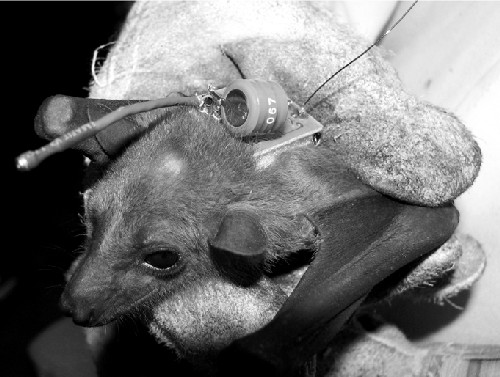
Rousettus aegyptiacus, a type of fruit bat
By James Dacey
Nope, this is not a scheme by the new British government to keep track of mischievous dogs.
This is one of the Egyptian fruit bats involved in research in England and Scotland to unlock the secrets behind bats’ remarkable ability to “see” in the dark.
It is well known that bats use the echoes from their own calls to recreate the landscape through which they are flying.
This is the same basic principle that underpins sonar technology used by submarines to map out the ocean floor and to detect other vessels.
Bats, however, have a super duper version of sonar which enables them to resolve their surroundings in much finer detail. Their two ears receive the echoes at slightly different times and at different loudness levels, depending on the position of the object generating the echoes, enabling them to perceive distance and direction.
Many bats also have an inbuilt acoustic gain control that allows them to emit high-intensity calls without deafening themselves and then to apply a gain to returning signals.
Simon Whiteley at the University of Strathclyde in Scotland has led a team to create a special sensor to monitor this process, which was then mounted onto the backs of a number of Rousettus aegyptiacus.
The six bats performed up to sixteen flights each along a flight corridor. Each flight was short – lasting only about three seconds – but, with the bats’ clicks only lasting a quarter of a millisecond, a large number of calls were recorded for the scientists to analyse.
Back in the lab, the researchers copied the animals’ functions by recreating the bat chirps and receiving them using a spectral equalization technique.
Their findings are published this week in Bioinspiration and Biomimetics.
Whiteley’s team will continue studying these bats with a view to developing applications such as positioning systems for robots.



